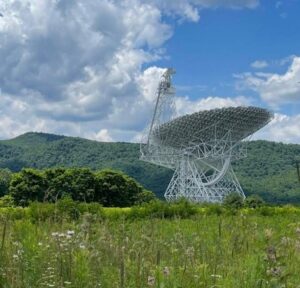Published on: July 29, 2023
Fast radio bursts
Fast radio bursts
Why in news? An international team of astronomers has published results of exhaustive study on repeating Fast radio bursts(FRB) from a distant galaxy
FAST RADIO BURSTS
- Bright bursts of radio waves produced by astronomical objects with changing magnetic fields
- Their durations lie in the millisecond-scale
- First discovered in 2007
- Named by the date of their discovery. Ex: FRB 20190520B
- Some spotted just once, never detected again and others are repeaters
CURRENT STUDY
- Study of FRB 20190520B was done using Green Bank Telescope in the U.S. and the Parkes Observatory in Australia
- FRB’s Faraday rotation measure is an indicator of its magnetic field strength
- This value for the given FRB was highly variable and that magnetic field reversed direction twice meaning it is a binary FBR
- It is binary owing to FRB source orbiting a binary star system where the companion star is probably a massive star or a black hole
- Researchers concluded as the given FRB is similar to most of FRB’S, it is possible most of FRB’s are binary for which further study is needed
Which are the new generation telescope used in tracking FRB’s?
- Very Large Array and Deep Synoptic Array-110 in the U.S.
- China’s Five-hundred-meter Aperture Spherical radio Telescope
- The Australian Square Kilometre Array Pathfinder
- India’s upgraded Giant Metre-wave Radio Telescope
- Germany’s Effelsberg Radioteleskop
- South Africa’s MeerKAT, and the Low-Frequency Array in the Netherlands.
Why do radio telescopes matter?
- Long wavelengths allow radio waves to cross space without interruption, helps to identify radio emissions from faraway heat sources.
- Telescopes that localise FRBs with arc-second precision could hunt for the FBR’s host
- It helps to unravel cosmic mysteries and understand the universe better

